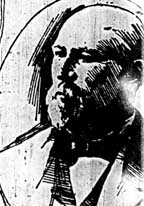
READ CHAPTER 1
GALLERY
WHO'S WHO
ATLAS
MYTHS DEBUNKED
FAMILY TREE
CONTACT THE AUTHOR
UPCOMING EVENTS
REVIEWS
CHICAGO HISTORY LINKS
READING SUGGESTIONS
BUY THIS BOOK
What Happened to the Bones?
The fate of this crucial evidence is a mystery, but now a possible answer has emerged.
Chicago police found the small bone fragments in May 1897 at the factory of Adolph Luetgert and claimed that they were all that remained of Luetgert's missing wife, Louise. Over the course of two trials, dueling scientific experts gave conflicting testimony about whether the bones had come from a human skeleton. Modern court and police officials have said they do not know what happened to the evidence after Adolph Luetgert's conviction in 1898.
Marie Chobot, a 91-year-old resident of Fergus Falls, Minn., says she knows.

"At the end of the trial, he just took them," Chobot said in a recent phone interview.
According to the story Harlev told his family when Chobot was a young girl, he sneaked the bone fragments out of the jury room at the end of that first trial. And when prosecutors put Luetgert on trial a second time and produced bones as evidence, Harlev knew that they had fabricated this evidence.
"He didn't dare say anything because he had broken a law," Chobot said.
She said her Harlev remained certain that Luetgert hadn't been proven guilty in either trial. "He was absolutely sure that they hadn't proved it," she said.
Chobot lived in the same house with Harlev as a girl. "I adored the man. He was wonderful," she said.
Harlev kept a box of newspaper clippings from the Luetgert trial as well as the bones. But she said never saw the bones with her own eyes; she just heard about them. "I never saw any of that," she said.
Harlev died in 1925, and about three years after that, the family moved from Chicago to the western suburb of Riverside. When the family moved, the old box with newspaper stories and bones was thrown out.
"When we moved from Chicago to Riverside, my mother said there was no point in keeping it any longer," Chobot said.
The idea of a juror taking home bones from a murder trial may sound far-fetched, but given the lax security in the Cook County Criminal Court in 1897, it is certainly not outside the realm of possibility.
If true, the story would explain discrepancies between the bones in the first trial and the second trial. At least some of the bones were lost between the trials, according to press accounts.
Although she is in her 90s, Chobot seemed to be quite lucid and sharp during the interview, and there is little reason to think she would have made up the story. Of course, since Chobot did not see the bones herself, it is possible Harlev was spinning a yarn when he told his family about the bones, but the story can't be entirely discounted.
If it were possible to locate the bones today, it might still be possible to perform DNA tests to determine if they belonged to Louise Luetgert — or in any case, belonged to a human being.
If Harlev's family discarded the bones, as Chobot recalls, then that is no longer a possibility. But it would still leave the question of what happened to the bones from the second Luetgert trial. And where they came from in the first place.
— Robert Loerzel, Oct. 22, 2005